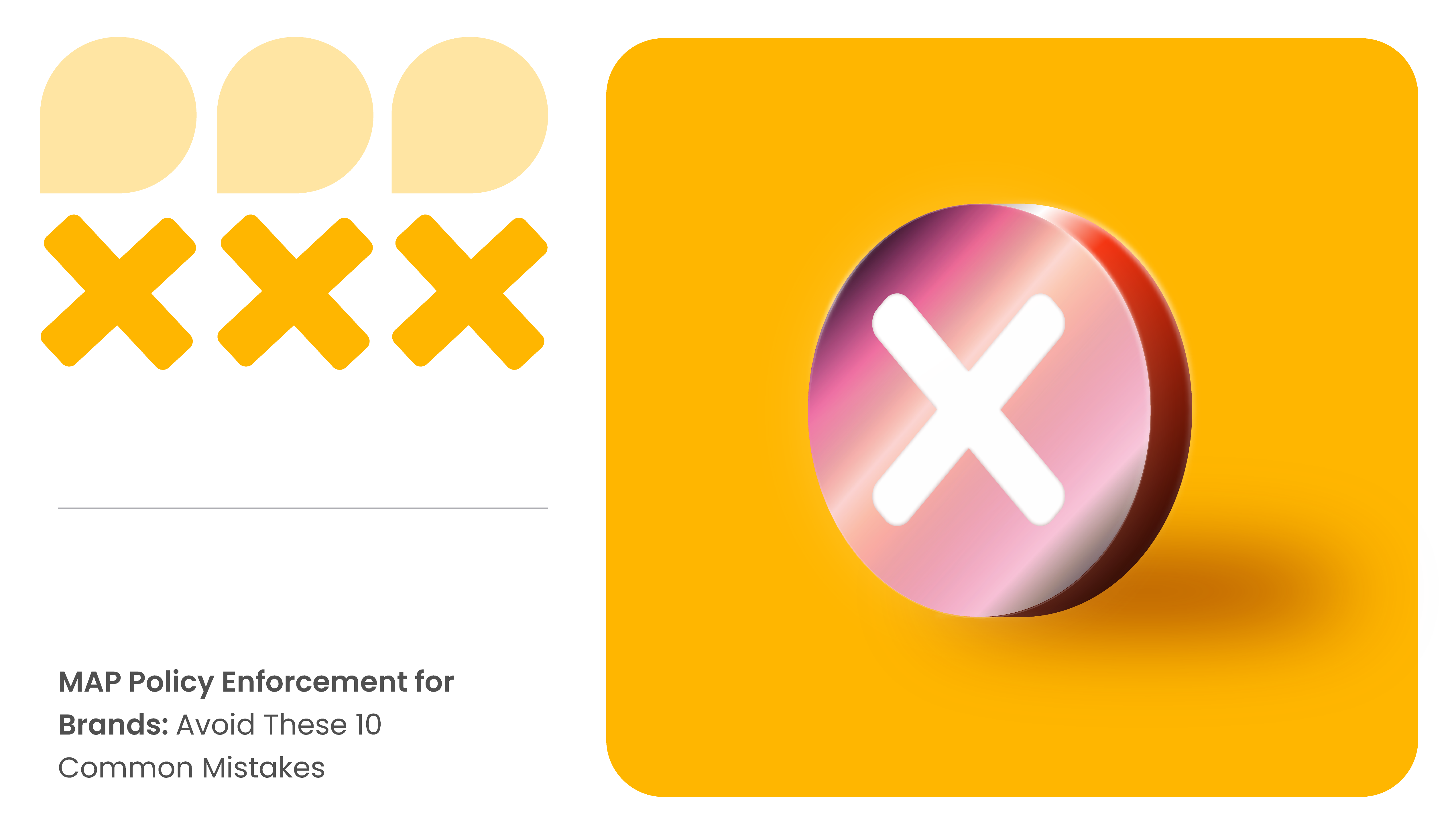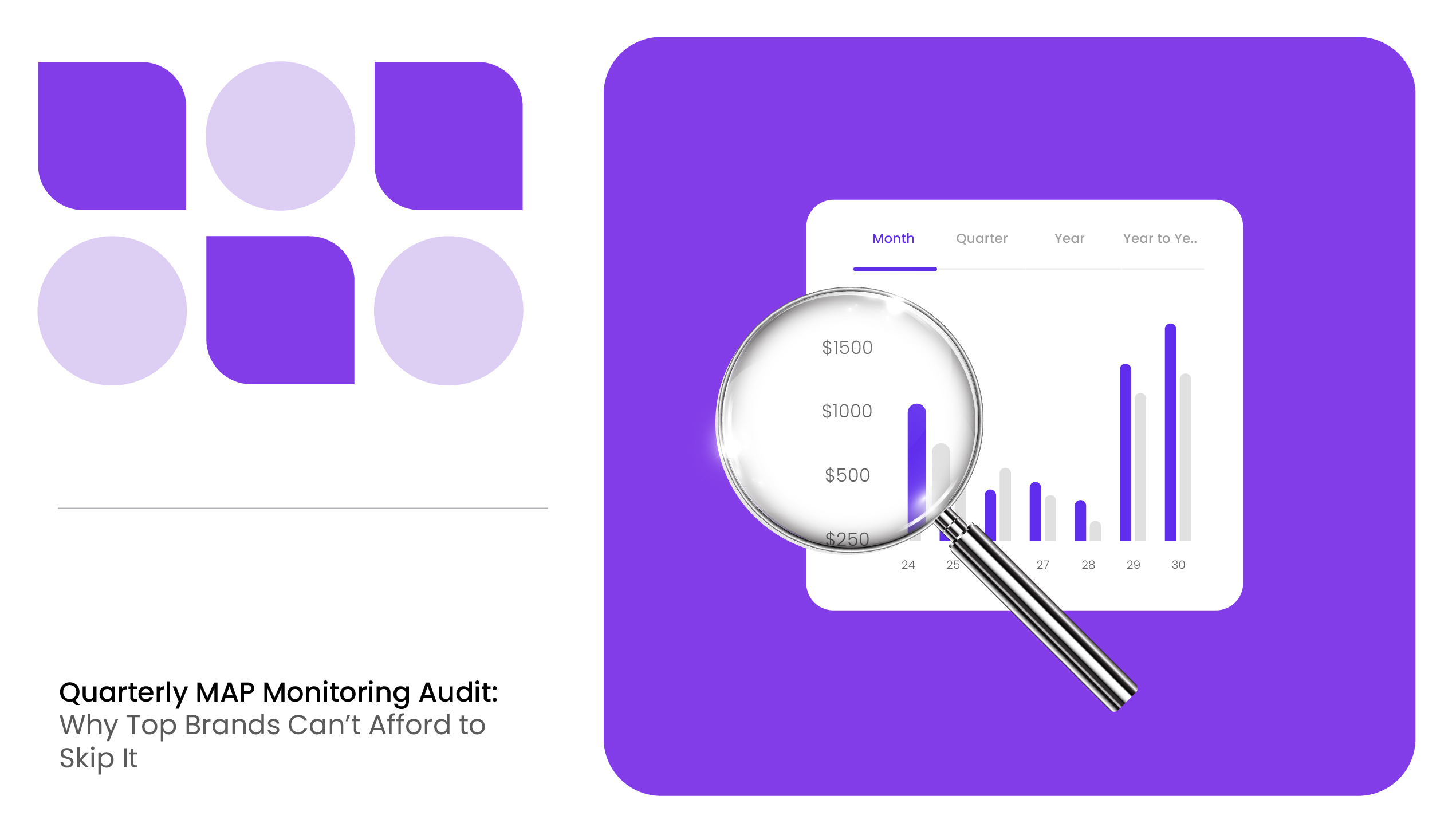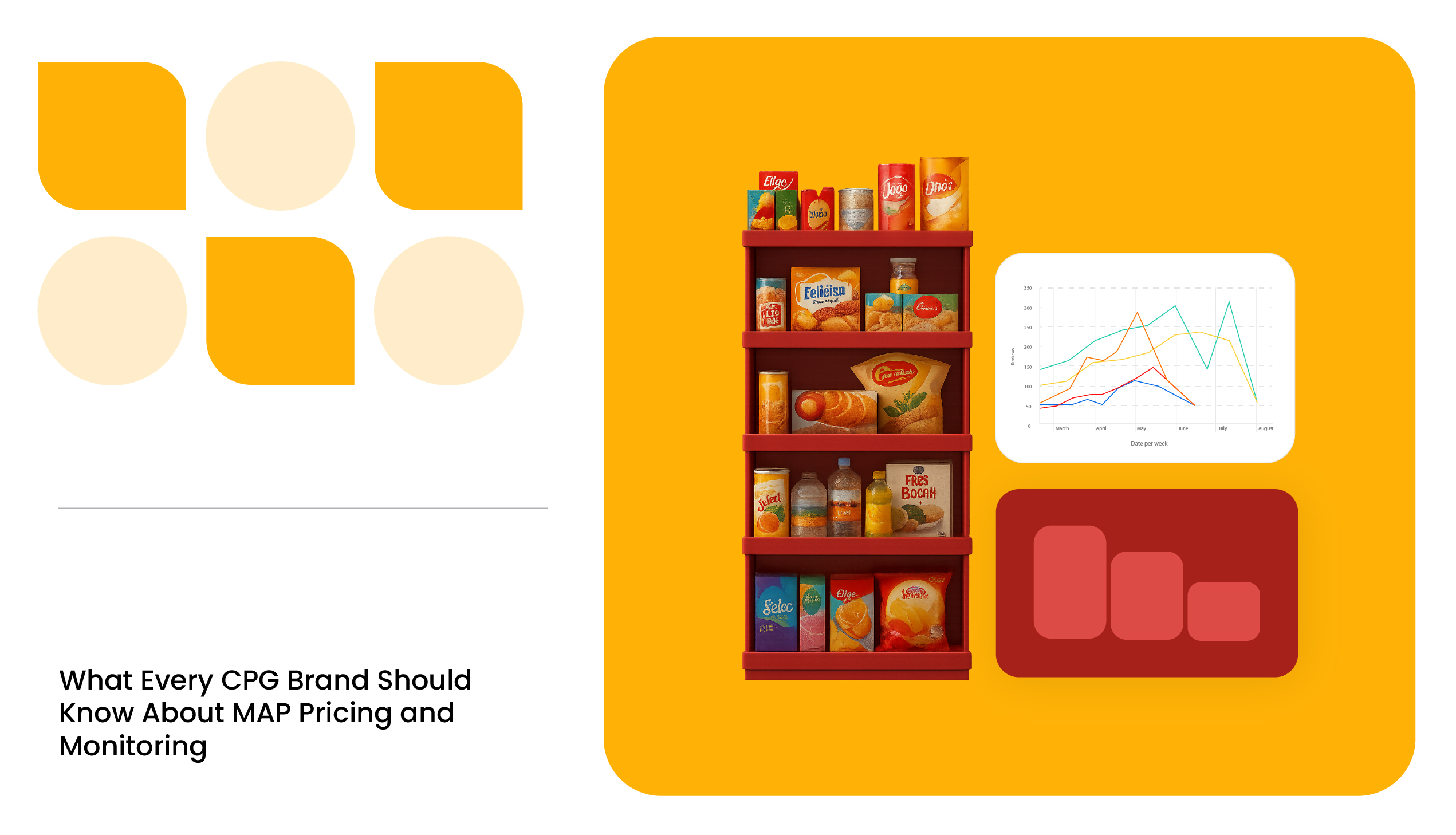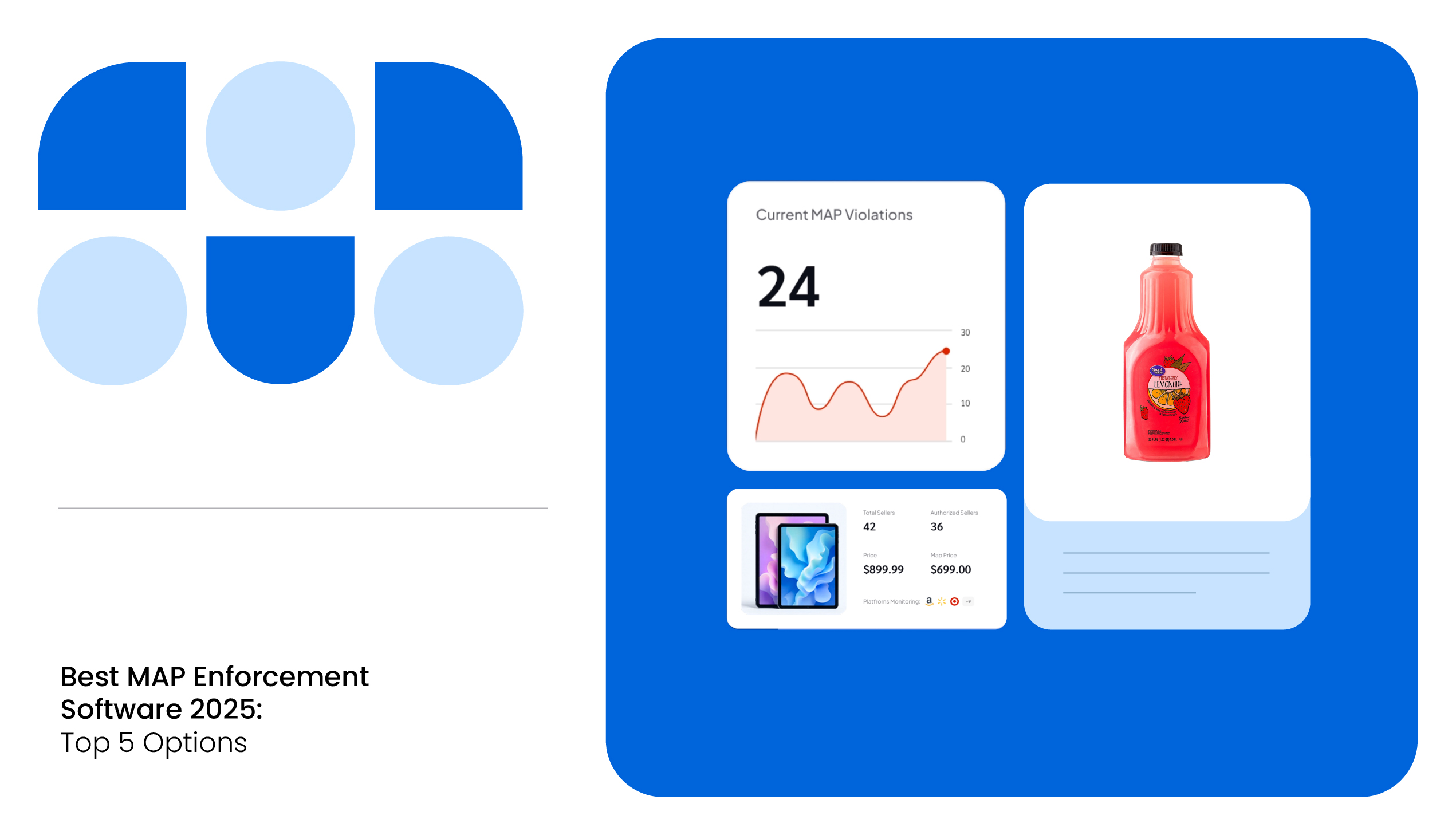It would be heartening to imagine an ideal scenario where your products are selling like hotcakes on the digital shelf, and you are expecting profits over the roof! But in real life, the market isn’t always a paradise for brands selling online.
A rogue reseller can cause price erosion, and in the blink of an eye, your premium brand image is in jeopardy. Customers begin to doubt the value of your products, loyal retailers feel undermined, and competitors are quietly cheering as chaos creeps into your well-oiled operation.
Welcome to the tricky world of MAP policy enforcement. For brands, MAP enforcement is like playing referee in a fast-paced game: you need clear rules, a watchful eye, and consistent penalties for violations.
So, it’s important to have the perfect MAP monitoring software that can help you track violations and impose penalties without unnecessary complications. Here are some things to avoid when while doing MAP policy enforcement.
READ MORE | Do you need MAP monitoring when selling online? Check out our blog on E-Commerce MAP Monitoring: The Must-Know Aspects for Brands.

1. Don’t Require Reseller Signatures on Your MAP Policy
It might seem logical to get retailers to sign off on your MAP policy as a way to ensure compliance. However, this can create legal issues.
Here’s what could go wrong:
- In many jurisdictions, requiring signatures on a MAP policy can turn it into a binding agreement, leading to antitrust concerns.
- When MAP policies are viewed as contracts, they risk being subject to price-fixing regulations and vertical price-fixing laws.
- It can lead to operational complexity and create an administrative burden with contracts that need to be tracked and enforced.
Design your MAP policy as a unilateral statement, one that outlines your rules and your intentions, and regularly educate resellers about the policy. Clearly communicate that compliance is a condition of doing business with your brand, but keep the policy non-negotiable and independent of formal agreements.
By automating MAP violation detection, MetricsCart ensures you don’t need to rely on signed agreements to track violations. It helps enforce compliance efficiently while keeping your legal exposure minimal.
2. Avoid Turning MAP Into Price-Fixing
One of the biggest MAP policy mistakes brands make is confusing MAP with price controls. MAP policy only extends to advertised prices, not the actual selling prices that retailers can charge. Dictating selling prices crosses into price-fixing territory, which is illegal in most regions.
Here’s what can go wrong:
- Legal Risks: Price-fixing is illegal and can lead to significant fines or lawsuits.
- Retailer Frustration: Overreach can discourage retailers from participating in your MAP program due to perceived restrictions on their pricing flexibility.
- Market Disruption: Imposing price controls creates a lack of competitive pricing, potentially pushing your product out of competitive market spaces.
Brands should focus solely on the advertised prices. Your MAP policy should always state that while retailers are free to set their prices, advertised prices must align with your MAP guidelines. This distinction is crucial to staying on the right side of the law.
3. Don’t Ignore MAP Monitoring Tools
Manually tracking hundreds (or thousands) of SKUs across multiple marketplaces and online retailers is practically impossible.
This is how it would end up:
- Missed Violations: Manual tracking all SKUs across multiple platforms will inevitably result in missed violations.
- Inefficiency: Without automation, monitoring is time-consuming and prone to errors.
- Inconsistent Enforcement: Manual checks create gaps in enforcement, allowing violations to persist without corrective action.
Brands that rely solely on sporadic checks miss violations and allow bad behavior to persist, which erodes trust in your MAP policy.
Invest in an intelligent and practical MAP monitoring tool like MetricsCart that will help automate the process, providing real-time alerts for violations. Proactive monitoring not only saves time but also reinforces your commitment to consistent enforcement.
READ MORE | Unsure about which MAP monitoring software to use? Check out our blog on the Best MAP Monitoring Software You Should Consider for E-Commerce.
4. Don’t Use Generic MAP Policy Templates
Your brand is unique, so why would a one-size-fits-all MAP policy work for you? Generic templates often fail to address the nuances of your product range, target markets, and retailer relationships.
- Lack of Specificity: A generic MAP policy might set a broad guideline like “products must not be advertised below $10.” However, it doesn’t differentiate between product types or regions. Without this specificity, resellers might violate the policy by advertising lower prices for regular stock, unintentionally damaging the perceived value of premium products.
- Ineffective Enforcement: A generic template may state that “all products are covered by the MAP policy,” but it fails to mention that some products (e.g., seasonal items) have different promotional allowances. Without clear exceptions and guidelines, the policy becomes harder to enforce, and resellers may push the boundaries.
- Confusion: Using vague language like “advertisements should reflect fair pricing,” but it doesn’t clarify what constitutes “fair pricing.” Retailers may interpret this differently depending on their business model, leading to inconsistent adherence across resellers.
Customize your MAP policy according to your market expectations and outline the specific products it applies to.
Also, define clear consequences for non-compliance and tailor your language to fit your brand’s tone and legal framework. A well-crafted policy reflects your brand’s professionalism and builds credibility with resellers.
MetricsCart’s MAP compliance tool helps you easily identify where the policy is being misinterpreted or violated, especially in different market conditions. The real-time insights into pricing trends across platforms allow you to adapt your MAP policy to adjust to market fluctuations and product-specific needs.
READ MORE | Unsure about creating MAP violation email templates? Check out our blog on MAP Violation Email Templates: How to Communicate with Retailers?
5. Avoid Inconsistent MAP Enforcement
Nothing undermines MAP policy best practices faster than uneven enforcement. If some resellers face penalties while others are given a free pass, your policy loses its teeth. Retailers will quickly notice and may stop taking your rules seriously.
This would end up looking like:
- Undermined Trust: Inconsistent enforcement leads to resentment and can cause retailers to question the policy’s integrity.
- Policy Erosion: Violators may feel emboldened to disregard the policy if penalties aren’t applied evenly.
- Legal and Competitive Risks: Favoring certain retailers could be seen as anti-competitive, opening your brand to legal action.
It is crucial to enforce your MAP policy consistently, regardless of the retailer’s size or relationship with your brand. Develop a structured response plan, such as a three-strike system, to ensure fair and transparent enforcement.
6. Don’t Neglect Communication With Retailers
A lack of clear communication with your retail partners can lead to confusion and resistance. If retailers don’t fully understand your MAP policy or feel unsupported, they’re less likely to comply.
Neglecting communication can lead to:
- Confusion and Non-Compliance: Retailers who don’t fully understand the policy may unintentionally violate it.
- Frustration: Lack of clear communication may lead to frustration, reducing retailer buy-in.
- Slow Response to Issues: Without ongoing communication, problems may go unaddressed, exacerbating violations.
Educate your retailers about the purpose and benefits of your MAP policy. Highlight how it protects their margins and levels the playing field. Provide them with resources, such as FAQs or training sessions, to ensure they’re well-informed.

7. Avoid Turning a Blind Eye to MAP Violations
It’s tempting to ignore minor infractions, especially from high-performing retailers. But turning a blind eye sets a dangerous precedent. If one retailer gets away with a violation, others may follow suit, creating a snowball effect.
Habitually ignoring MAP violations can lead to:
- Escalating Violations: Ignoring small violations can lead to larger price erosion across resellers.
- Erosion of Trust: If some violations are overlooked, other retailers will follow suit, weakening policy integrity.
- Competitive Advantage: Non-compliant gray market sellers can undercut prices, creating an unfair advantage and disrupting the market.
So, it is essential to address all violations, no matter how small. Use automated Minimum Advertised Price tracking tools to identify breaches quickly and take action immediately.
Whether it’s a warning, a suspension of benefits, or termination of the relationship, follow through diligently on your stated consequences.
8. Don’t Forget To Address Unauthorized Sellers
Unauthorized sellers are notorious for violating MAP pricing, often operating under the radar. Ignoring these sellers not only undermines your MAP policy but also dilutes your brand protection and value.
Forgetting to address unauthorized sellers can snowball into:
- Price Erosion: Unauthorized sellers typically don’t comply with MAP, undercutting prices and eroding your brand’s perceived value.
- Brand Damage: Non-compliant sellers may not provide the level of service your authorized retailers do, damaging your brand’s reputation.
- Loss of Control: Ignoring unauthorized sellers undermines your control over product distribution and pricing.
Implement measures to identify and track unauthorized sellers. Work with legal counsel to send cease-and-desist letters or take further action as needed. Consider using tools like MetricsCart to help enforce MAP compliance across unauthorized channels.
9. Avoid Overcomplicating Your MAP Policy
A convoluted MAP policy filled with legal jargon and endless clauses can confuse retailers and deter compliance. Complexity often leads to misunderstandings and inconsistent enforcement.
- Confusion: Overly complex language can confuse retailers, leading to violations due to misunderstandings.
- Non-Compliance: A complicated MAP policy is difficult to follow, resulting in inconsistent enforcement and reduced compliance.
- Reduced Effectiveness: The harder it is for retailers to understand the policy, the less likely they are to follow it.
Keep your MAP policy concise and easy to understand. Use clear, plain language to explain your rules, and provide examples where necessary. A straightforward policy is far more likely to be followed than a complex one.
10. Don’t Assume One Policy Fits All Regions
MAP policies often need to accommodate different legal and market environments, mainly if your brand operates internationally. A single policy may not account for regional variations in laws and consumer behavior.
Here’s how it can go wrong:
- Legal Complications: A global MAP policy that doesn’t account for local regulations may violate regional laws, leading to legal repercussions.
- Market Mismatch: Consumer behavior and pricing structures vary greatly by region, and one policy might not be effective or relevant everywhere.
- Loss of Sales Opportunities: Not tailoring your MAP policy to regional dynamics may limit your ability to compete effectively in diverse markets.
Adapt your MAP policy for each region or country where your brand is active. Collaborate with local legal experts to ensure compliance with regional laws and regulations while maintaining the integrity of your global strategy.
Here’s How We Can Help
MAP enforcement isn’t just about protecting prices; it’s about preserving the value of your brand, fostering trust with retailers, and ensuring a level playing field in the marketplace. Avoiding some common mistakes can help you enforce your MAP policy effectively and with integrity.
MetricsCart offers a wide range of features for MAP monitoring:
- Identify patterns and high-risk periods for MAP non-compliance.
- Categorize sellers into compliant and non-compliant groups.
- Track Amazon Buy Box wins and losses caused by MAP violation.
- Store price violation screenshots for transparent enforcement and dispute resolution.
- Pinpoint sellers breaching MAP policy for streamlined corrective actions.
The goal isn’t just to enforce compliance; it’s to build long-term partnerships with your retailers and create a seamless customer experience. With a clear, well-communicated, and consistently enforced MAP policy, your brand can navigate the complexities of e-commerce with confidence.
Enforce MAP Policies Effortlessly and Protect Your Margins Today!
FAQs
Regular reviews, ideally quarterly, help ensure that your enforcement strategies are effective and adapt to changing market dynamics.
Tools like MetricsCart and other digital shelf analytics software provide automated price monitoring, reporting, and enforcement support to simplify the process.
Yes, MAP policies are enforceable in most regions, but they must comply with local laws to avoid anti-competitive practices. Consult legal experts to ensure compliance.
Challenges include monitoring a large number of sellers, dealing with unauthorized resellers, and ensuring timely action against violations without damaging relationships.
Yes, strong MAP enforcement shows authorized retailers that the brand values fair competition, fostering loyalty and partnership.







